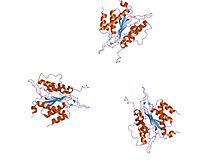- EcoRI
-
EcoRI 
the crystallographic structure of restriction endonuclease eco ri at 3.3 a in the absence of dna Identifiers Symbol EcoRI Pfam PF02963 InterPro IPR004221 SCOP 1na6 Available protein structures: Pfam structures PDB RCSB PDB; PDBe PDBsum structure summary EcoRI (pronounced "eco R one") is an endonuclease enzyme isolated from strains of E. coli, and is part of the restriction modification system.
In molecular biology it is used as a restriction enzyme. It creates sticky ends with 5' end overhangs. The nucleic acid sequence where the enzyme cuts is GAATTC, which, as the complementary sequence is CTTAAG, has rotational symmetry.
Contents
Structure
Primary Structure
EcoRI contains the PD..D/EXK motif within its active site like many restriction endonucleases. It is typically used in the isolation and restriction of bacterial plasmid DNA. In EcoRI this motif consists of residues P90, D91, E111, A112, K113(2)1.
Tertiary and Quaternary Structure
The enzyme is a homodimer of a 31 kilodalton subunit consisting of one globular domain of the α/β architecture. Each subunit contains a loop which sticks out from the globular domain and wraps around the DNA when bound (3).
EcoRI has been cocrystallized with the sequence it normally cuts. This crystal was used to solve the structure [1] of the complex. The solved crystal structure shows that the subunits of the enzyme homodimer interact with the DNA symmetrically(3). In the complex, two α-helices from each subunit come together to form a four helix bundle(2). On the interacting helices are residues Glu144 and Arg145, which interact together forming a crosstalk ring that is believed to allow the enzyme's two active sites to communicate(4).
Uses
Restriction enzymes such as EcoRI are used in a wide variety of molecular genetics techniques including cloning, DNA screening and deleting sections of DNA in vitro. Restriction enzymes like EcoRI that generate sticky ends of DNA are often used to cut DNA prior to ligation, as the sticky ends make the ligation reaction more efficient. EcoRI can exhibit non site-specific cutting, known as star activity, depending on the conditions present in the reaction. Conditions that can induce star activity when using EcoRI include low salt concentration, high glycerol concentration, excessive amounts of enzyme present in the reaction, high pH and contamination with certain organic solvents[1].
See also
- EcoRII, another nuclease enzyme from E. coli.
- EcoRV, another nuclease enzyme from E. coli.
References
- ^ http://www.neb.com/nebecomm/products/faqproductR0101.asp#1
- ^ Bitinaite, J., D. A. Wah, Aggarwal, A. K., Schildkraut, I. (1998). "FokI dimerization is required for DNA cleavage". Proc Natl Acad Sci U S A 95 (18): 10570–5. doi:10.1073/pnas.95.18.10570. PMC 27935. PMID 9724744. http://www.pubmedcentral.nih.gov/articlerender.fcgi?tool=pmcentrez&artid=27935.
- ^ Pingoud, A., Jeltsch, A. (2001). "Structure and function of type II restriction endonucleases". Nucl. Acids Res 29 (18): 3705–3727. doi:10.1093/nar/29.18.3705. PMC 55916. PMID 11557805. http://www.pubmedcentral.nih.gov/articlerender.fcgi?tool=pmcentrez&artid=55916.
- ^ Kim, Y.C., Grable, J.C., Love, R., Greene, P.J., Rosenberg, J.M. (1990). "Refinement of Eco RI endonuclease crystal structure: a revised protein chain tracing". Science 249 (4974): 1307–1309. doi:10.1126/science.2399465. PMID 2399465.
- ^ Kurpiewski, M.R., Engler, L.E., Wozniak, L.A., Kobylanska, A., Koziolkiewicz, M., Stec, W.J, Jen-Jacobson, L (2004). "Mechanisms of coupling between DNA recognition and catalysis in EcoRI endonucleases". Structure 12: 1775–1788. doi:10.1016/j.str.2004.07.016. PMID 15458627.
External links

This hydrolase article is a stub. You can help Wikipedia by expanding it.


